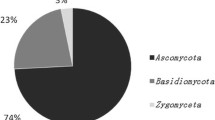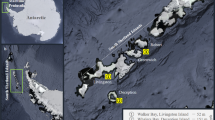Abstract
Marine fungi are known to originate from a wide variety of habitats within the marine environment. Marine sediment represents one environmental niche, with most fungi occurring in these sediments being facultative marine fungi with terrestrial origins. It has not been proven whether these fungi merely survive the harsh environmental conditions presented by the ocean sediment, as opposed to playing an active role in this ecological niche. During this study, marine sediment was collected from St. Helena Bay, on the west coast of the Western Cape, South Africa. Using dilution, enrichment, and repetitive culturing techniques, 59 fungal isolates were obtained from marine sediments and identified to at least genus level using morphological and molecular methods. Moreover, a series of tests were performed to characterize the physical and physicochemical attributes of the isolates. Results showed that the isolates not only survived but also had the potential to grow in the natural conditions present in this environment. Extracellular cellulase was produced by the filamentous fungal isolates indicating their probable role in detrital decay processes and therefore the carbon cycle on the ocean bed. Also, denitrification patterns were observed when isolates were grown in liquid media amended with NaNO2, NaNO3 , and (NH4)SO4, implicating that these fungi have the potential to play an active role in denitrification, co-denitrification, and ammonification phases of nitrogen cycles occurring in the marine sediments.


Similar content being viewed by others
References
Barnett JA, Payne RW, Yarrow D (2000) Yeasts: Characteristics and identification, 3rd edn. Cambridge University Press, Cambridge
Burgaud G, Le Calvez T, Arzur D, Vandenkoornhuyse P, Barbier G (2009) Diversity of culturable filamentous fungi from deep-sea hydrothermal vents. Environ Microbiol 11:1588–1600
Cathrine SJ, Raghukumar C (2009) Anaerobic denitrification in fungi from the coastal marine sediment off Goa, India. Mycol Res 113:100–109
CSIR Report ENV-S-C 2002-050/A (2002) St. Helena Bay Quality Water Trust: the biochemical status of surface sediments in St. Helena Bay in 2001
CSIR Report ENV-S-C (2007) St. Helena Bay Quality Water Trust: the biochemical status of surface sediments in St. Helena Bay
De Hoog GS, Guarro J, Gené J, Figueras MJ (2000) Atlas of clinical fungi, 2nd edn. Centraalbureau for Scimmelcultures, Utrecht
Egli K, Fanger U, Alvarez PJJ, Siegrist H, Van der Meer JH, Zehnder AJB (2001) Enrichment and characterization of an anammox bacterium from a rotating biological contactor treating ammonium-rich leachate. Arch Microbiol 175:198–207
Golubic S, Radtke G, Le Campion-Alsumard T (2005) Endolithic fungi in marine ecosystems. Trends Microbiol 13:229–235
Greben HA, Joubert L-M, Tjatji MP, Whites HE, Botha A (2007) Biological nitrate removal from synthetic wastewater using a fungal consortium in one stage bioreactors. Water SA 33:285–290
Hayatsu M, Tago K, Saito M (2008) Various players in the nitrogen cycle: diversity and functions of the microorganisms involved in nitrification and denitrification. Soil Sci Plant Nutr 54:33–45
Hyde HD, Jones EBG, Leaño E, Pointing SB, Poonyth AD, Vrijmoed LLP (1998) Role of fungi in marine ecosystems. Biodivers Conserv 7:1147–1161
Hyde KD, Sarma VV, Jones EBG (2000) Morphology and taxonomy of higher marine fungi. In: Hyde KD, Pointing SM (eds) Marine mycology—a practical approach. Fungal Diversity Research, Hong Kong, pp 172–204
Jones EBG (2000) Marine fungi: some factors influencing biodiversity. Fungal Divers 4:53–73
Kartal B, Koleva M, Arsov R, Van der Star W, Jetten MSM, Strous M (2006) Adaptation of a freshwater anammox population to high salinity wastewater. J Biotechnol 126:546–553
Khudyakova YV, Pivkin MV, Kuznetsova TA, Svetashev VI (2000) Fungi in sediments of the sea of Japan and their biologically active metabolites. Microbiology 69:608–611
Kohlmeyer J, Kohlmeyer E (1979) Marine mycology. The higher fungi. Academic, New York
Kurtzman CP, Fell JW (2000) The yeasts. A taxonomic study, 4th edn. Elsevier Science BV, Amsterdam
Monteiro PMS, Roychoudhury AN (2005) Spatial characteristics of sediment trace elements in an eastern boundary upwelling retention area (St. Helena Bay, South Africa): a hydrodynamic–biological pump hypothesis. Estuar Coast Shelf S 65:123–134
Raghukumar C (1992) Endolithic fungi from deep sea calcareous substrata: isolation and laboratory studies. In: Desai BN (ed) Oceanography of the Indian Ocean. Oxford and IBH, New Delhi, pp 3–9
Raghukumar C (2008) Marine fungal biotechnology: an ecological perspective. Reviews Crit New Technol Fungal Divers 31:19–35
Shoun H, Kim D-H, Uchiyama H, Sugiyama J (1992) Denitrification by fungi. FEMS Microbiol Lett 94:277–282
Singh P, Raghukumar C, Verma P, Shouche Y (2011) Fungal community analysis in the deep-sea sediments of the central Indian basin by culture-independent approach. Microb Ecol 61:507–517
Sparrow FK Jr (1937) The occurrence of saprophytic fungi in marine muds. Biology Bull 73:242–248
Steele CW (1967) Fungus populations in marine waters and coastal sands of the Hawaiian, Line, and Phoenix Islands. Pac Sci 21:317–331
St Leger RJ, Nelson JO, Screen SE (1999) The entomopathogenic fungus Metarhizium anisopliae alters ambient pH, allowing extracellular protease production and activity. Microbiology 145:2691–2699
Takami H (1999) Isolation and characterization of microorganisms from deep-sea mud. In: Horikoshi K, Tsujii K (eds) Extremophiles in deep-sea environments. Springer, Tokyo, pp 3–26
Takaya N (2002) Review. Dissimilatory nitrate reduction metabolisms and their control in fungi. J Bio Sci Bioeng 94:506–510
Tatsunori F, Akira I, Kazuhito M, Koki H (1994) Isolation of a marine yeast that degrades hydrocarbon in the presence of organic solvent. Bio Sci Biotech Bioch 58:1784–1788
Vrijmoed LLP (2000) Isolation and culture of higher filamentous fungi. In: Hyde KD, Pointing SM (eds) Marine mycology—a practical approach. Fungal Diversity Research, Hong Kong, pp 1–20
Wang G, Li Q, Zhu P (2008) Phylogenetic diversity of culturable fungi associated with the Hawaiian sponges Suberites zeteki and Gelliodes fibrosa. A Van Leeuw 93:163–174
Weston NB, Joye SB (2005) Temperature-driven decoupling of the key phases of organic matter degradation in marine sediments. PNAS 102:17036–17040
White TJ, Bruns T, Lee S, Taylor DJ (1990) Amplification and direct sequencing of fungal ribosomal RNA genes for phylogenetics. In: Innes MA, Gelfand DH, Sninsky JJ, White TJ (eds) PCR protocols. Academic, San Diego, pp 315–322
Author information
Authors and Affiliations
Corresponding author
Rights and permissions
About this article
Cite this article
Mouton, M., Postma, F., Wilsenach, J. et al. Diversity and Characterization of Culturable Fungi from Marine Sediment Collected from St. Helena Bay, South Africa. Microb Ecol 64, 311–319 (2012). https://doi.org/10.1007/s00248-012-0035-9
Received:
Accepted:
Published:
Issue Date:
DOI: https://doi.org/10.1007/s00248-012-0035-9




